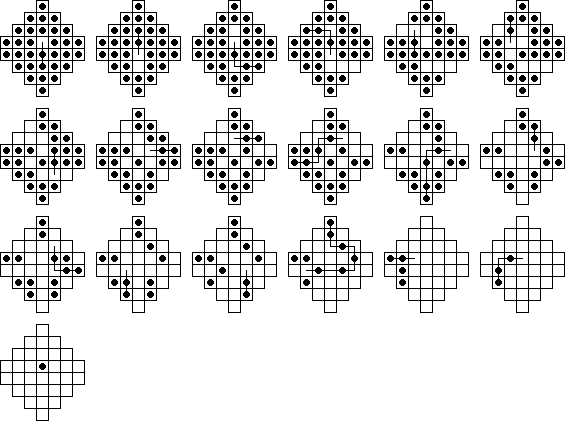

Make a new move with drag and drop, it is insert in the historyĪnd the rest of the history is discarded. The game plays to the end of the move history. The move is illustrated, and you may make The (or one of the) highlighted aims to perform the move, or drop If you move the mouse-pointer over a stone that can be moved, One being placed in the centre of the board. The goal is to remove all stones but one, and this last
Peg solitaire solving algorithm free#
The rules of the game are simple: each stone that can jumpĮither horizontally or vertically over its neighbour and land onĪ free place is allowed to be moved. Switch and a eventually performing run is aborted.īecause the standard layout is more popular, the rest of theĮxplanations (except of the special chapters on the french typ) Versions, but the existing population is deleted with every With the radio-buttons you may switch between the two Known as the french type, called the 36-peg-solitaire. There exists a mean "XL-version" of solitaire with 4Įxtra holes (follow the link to find out why it is mean), also Shift-click opens an info-window displaying several parameters Population this happens automatically after several unsuccessfulĬlicking on a candidate opens a solitaire-window, where theĮvaluation game of that candidate is shown, even if it is not the With Make Population you restart the search with a new

When the applet is running, the >-ButtonĬhanges into a X-Button, which you stop the applet with. When theĪpplet has finished, you click on the candidate in the upper leftĬorner to open a solitaire-window in which the found solution can Lead to the solution or to a pattern near the solution. Which the applet generates and tests (evaluates) whether they Solution found in nth population after nn Start with the X-Button, sit back and wait until the appletĭisplays Done. Your provider, as the connection isn't required any longer.): You (As soon as the appletsĭownload to your browser has completed, you may cut the line to This is not a built-in, predefined solution, but sought in On the other hand, you can let the applet search a solution. Your game and use your mouse and the buttons to move, goīack and forth through the history of moves or let rerun the With this applet you can play solitaire on one hand: Open a solitaire-window with the button play Your browser does not support java or java is diabled
Peg solitaire solving algorithm code#
We only need to check half of the board, as the solutions of the other half would be symmetrical.īut despite these the code is still very slow.Java-Solitaire: Play or find solutions with a genetic algorithm: A java-applet for playing solitaire (peg-solitaire) with a genetic algorithm searching for solutions Java-Solitaire: Play or find solutions with a genetic.Optimizations I have come up with so far:

If re.search(expression1, string) or re.search(expression2, string): If board and board and not board:Įxpression1 = '1000+1' #RE for a proven to be unsolvable boardĮxpression2 = '00100' #RE for a proven to be unsolvable board So I was wondering if there are some optimizations I could do or different solution approaches. I have created a brute force algorithm which finds all the possible moves until a valid solution is reached, but it starts taking a very long time to find a solution past n > 20. The goal of the algorithm I am trying to make is to take an input of n where n > 2 and n is an even number, then for a board of length n, find all the positions for a start state at which a hole can be placed to produce a valid solution. So for a board such as board = there are two available moves. Your available moves at any given position is to move one peg by two positions to the right or to the left if and only if there is a peg between the two position, then once you make that move, replace the middle peg with a hole. The goal of the game is to reach a board state where n-1 elements are holes and 1 element is a peg at any given position. So a starting position can be where 1s represent pegs and 0s represent holes for n = 6 n-1 elements are pegs (filled) and 1 element is a hole (empty). You initially start with a 1 dimensional board of length n. First I will explain the rules of peg solitaire (for 1 dimension):


 0 kommentar(er)
0 kommentar(er)
